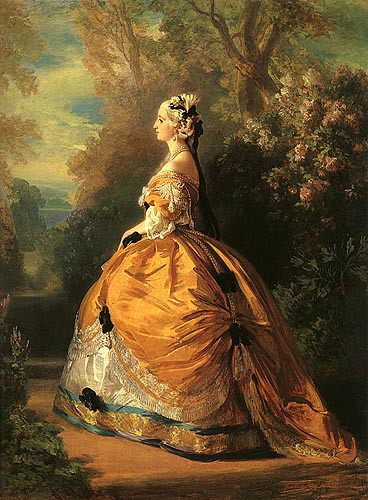Eugénie almost worshipped Marie-Antoinette. The tragic end of that 'martyr queen' obsessed the Empress throughout her reign, and especially after the fall of the Second Empire, when Eugénie began strongly to identify herself with her royal predecessor. Indeed the Austrian Queen and the Spanish Empress shared the same destiny, in that they were both non-french sovereigns who soon became targeted by the French people. Eugénie followed Marie-Antoinette almost step for step. She lived in the same palaces, she preferred the Trianon, she even surrounded herself with furniture and objects which had belonged to the guillotined queen, so much so that the very ornate Louis XVI style came back into fashion, Eugénie organising an exhibition in the Marie-Antoinette's memory.
This fascination can clearly be seen in Winterhalter's painting here, sometimes called “The Empress Eugénie à la Marie-Antoinette”. In profile, standing in a garden, Eugénie wears a yellow taffeta dress decorated with blue ribbons and black knots, and her hair is powdered in the ancien-régime fashion. Although clearly a pastiche of an eighteenth-century portrait, revealing a certain nostalgia for the past, it is also redolent of the costume balls for which the regime was famous. Eugénie seems to have worn this 'costume' simply for the sitting, however, in February 1866, a copy of a Marie-Antoinette dress was made for her for a costume ball.
Winterhalter executed at least nine paintings of the Empress, of which notably: an official portrait, a state portrait, a portrait with the Prince Impérial and perhaps his most famous, a group portrait, The Empress and her Matrons of Honour (L'impératrice entourée de ses dames d'honneur). Eugénie was to keep this portrait until the end of her life. And perhaps the final word should go the Goncourt brothers, merciless satirists of the late 19th-century France, whose commentary on the painting seems to echo Eugénie's feelings for the work:
“The woman is delightful, it must be said. Her eyes are all smiles, she has grace, and a beautiful posture, there is something charming in the way in which she passes before you. Neither queen nor princess – a empress of the Spa, an Empress not of France but of Baden Baden. A sort of, Mabille* Marie-Antoinette”.
Karine Huguenaud (tr. P.H.)
*Mabille was a famous Bal or dancehall of the period, where the Cancan was invented.
April 2003
The Empress Eugénie in 18th-century costume
Artist(s) : WINTERHALTER Franz-Xaver

- Date :
- 1854
- Technique :
- oil on canvas
- Dimensions :
- H = 0.927 m, L = 0.737 m
- Place held :
- New York, Metropolitan Museum of Art
- Photo credit :
- © CGFA

